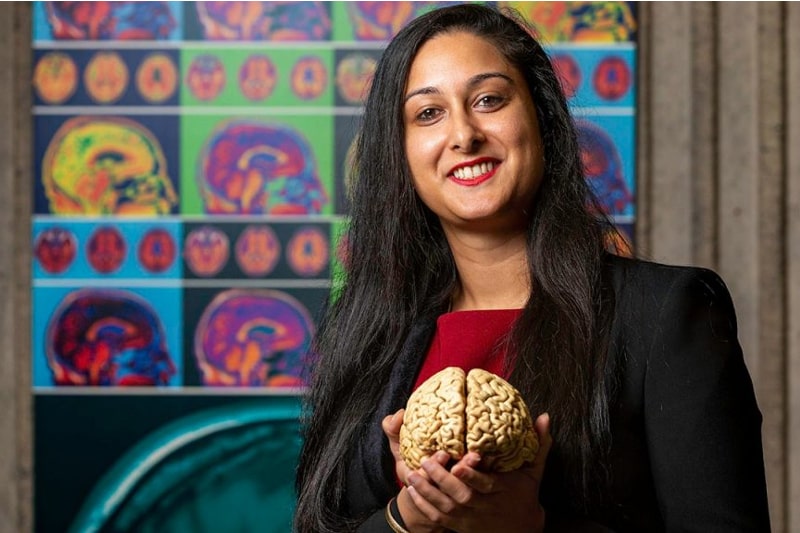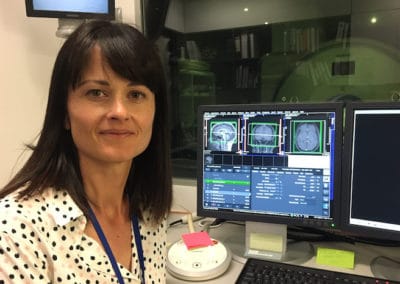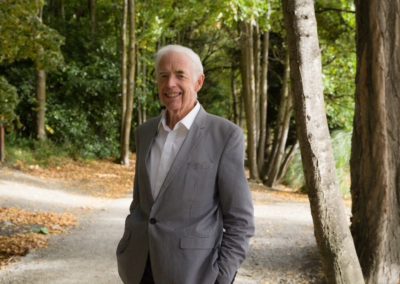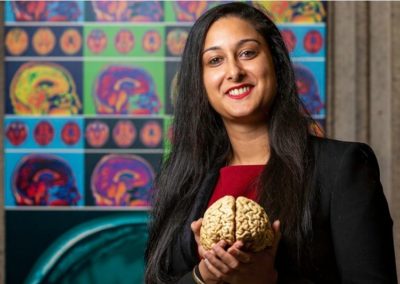Dr Malvindar Singh-Bains from Brain Research New Zealand and the Centre for Brain Research would like greater awareness of how the hereditary brain disease Huntington’s affects families.
Malvindar Singh-Bains was presenting her research at the National Huntington’s Disease Conference a few years back, when she was brought down to earth.
“My PhD project detailed the patterns of cell loss in regions of a brain with Huntington’s Disease and linked them to symptoms these patients had when they were alive,” says Malvindar, a research fellow in the Centre for Brain Research (CBR).
“The findings highlighted the importance of the community’s input because the donation of the brains of people with Huntington’s Disease is the key to unlocking why there are different symptoms.”
At the end of her presentation, a member of the public stood up and said, “OK, so you’re showing us the secrets of the post-mortem brain, but what are you doing for our kids who are alive?”
“I didn’t have an answer.”
That prompted Malvindar to set up Huntington’s Disease Youth Organisation NZ (HDYO-NZ), a support group for young people affected by Huntington’s, which is a sister organisation to the international Huntington’s Disease Youth Organisation. HDYO-NZ is a registered charitable trust that educates, advocates and supports anyone affected by Huntington’s, from children to adults before the onset of symptoms.
Surprisingly, there have been no proper incidence and prevalence studies of Huntington’s Disease in New Zealand. “We know that in Auckland/Northland we have about 900 people with it – either symptomatic or impacted by the gene – as they’re on the books of the Huntington’s Disease Association for Auckland. New studies show it could be as many as one in 10,000 people affected.”
“But there’s under-reporting because of the stigma. People don’t want to be included in these kinds of prevalence studies.”
Huntington’s Disease symptoms don’t generally show up until a person is between 35 and 55.People can have a test at 18 to find out if they have inherited the gene or live their lives not knowing for sure. Everyone has the HTT gene itself – it’s needed to make a protein called huntingtin which is vital for life – but people with a rogue HTT gene have one that is much longer, expanded and repeated, which leads to a build-up of “bad” protein in the brain.
The mutation that causes Huntington’s Disease involves a DNA segment known as a CAG trinucleotide repeat, made up of three DNA building blocks (cytosine, adenine and guanine) that appear multiple times. Normally, the CAG segment within the gene is repeated 26 times or fewer, but in people with Huntington’s Disease it has kept repeating.
“Whether you get it depends on the number of repeats. If you have 40 CAG repeats or more, you’re going to get Huntington’s Disease. If you have between 26 and zero, you won’t. There’s an intermediate group, 27-39 repeats, where you may or may not show Huntington’s in your lifetime but if you have children you may pass on the disease,” says Malvindar.
“What we know is that when you’re born, you don’t show symptoms. Through adolescence, you still have no symptoms. But researchers hypothesise that there are switches being turned on throughout life, and the last switch is the one that triggers the disease. It’s like an accumulation of insults over time.”
Malvindar says 70 to 75 percent of the disease onset is due to the gene, but researchers also believe around 25 percent is caused by other factors that trigger that switch.“It could be ageing, it could be chemicals, it could be medication, it could be environmental exposures … there are many possible triggers.”
Huntington’s Disease has been around for a long time. In 1872, American physician George Huntington reported seeing patients who looked intoxicated, walking along the street. This was the original description of Huntington’s Chorea.“Chorea is Latin for dance and these people were walking with writhing and convoluted dance-like movements,” explains Malvindar.
“George Huntington’s article also reported on a genetic inheritance pattern, but it wasn’t until the Huntington’s Disease Collaborative Research Group, which included Professor Russell Snell from this University, started studying the genes of patients from Lake Maracaibo, Venezuela, that there was a Eureka moment. They found a gene that was common between all those patients in Lake Maracaibo, where there is a high incidence.”
Malvindar says she was drawn to research Huntington’s because of Distinguished Professor Sir Richard Faull, the renowned neuroscientist in the Centre for Brain Research who was awarded the Rutherford Medal in 2007 for his ground-breaking work in understanding the human brain.
“What channelled me towards brain research was that Richard used to give five lectures in a paper called MedSci 142,” says Malvindar. “In that lecture series, it was pin-drop silence from all the students. He was so passionate about the brain being the last frontier for medical research. “You can replace a heart, you can replace a liver, you can replace a kidney, but you cannot replace a brain. That really hooked me in.”
She began working with him around three years later for her PhD. “Richard explained how Huntington’s has a key genetic feature that is unique to all of the patients with the disorder, but the myriad symptoms can sometimes be more dementia-like or more motor-like.”
“If we want to glean more about other disorders, such as Parkinson’s Disease and Alzheimer’s, Huntington’s is a great ‘model disorder’ because those diseases have similar pathophysiology. What’s common in the diseases is the death of brain cells, accompanied by an increase in bad proteins that build up in those brains.”
“We have many donor cases in our Human Brain Bank that show this. We have more than 700 brains and around 150 of those are Huntington’s, thanks to the amazing families of these people. Because of the genetic cause, families donate in the hope science can change the outcomes.”
“Huntington’s does look to be the most curable out of all the currently incurable neurodegenerative conditions, because we have its unique molecular signature. Motor neuron disease, for example, is incredibly complex because there are so many different genes that can cause it.”
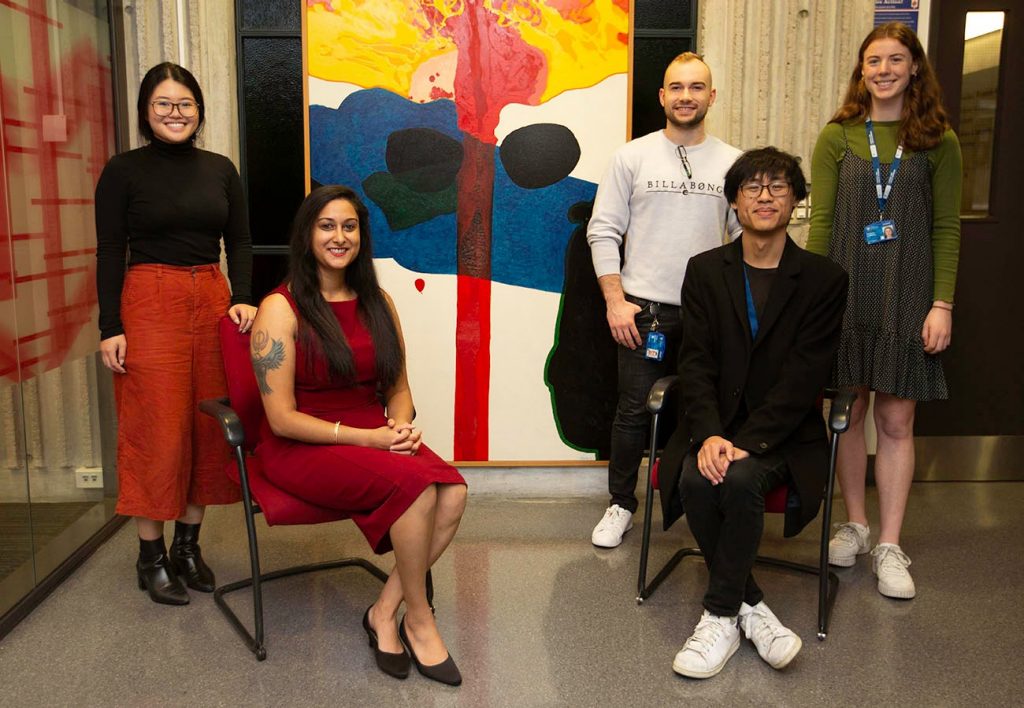
There was also a personal reason Malvindar ended up deciding on brain research. Both her maternal and paternal grandmothers had died with dementia. While she didn’t know her mother’s mother, who died when Malvindar was around two, she did see the progression of her paternal grandmother’s dementia.
“She lived in California and every two years I would go through California to Boston to go to the Hereditary Disease Foundation Conference to present my Huntington’s PhD work.”
“I’d stop at my grandma’s en route. I saw that progression and the impact it had on my family. My uncle was her main carer and he would talk about the challenges. Seeing her decline just reinforced how much I want to help people with brain disease have a better quality of life.”
That’s also where the Sikh concept of ‘seva’ comes in. Seva means ‘selfless service’ and Malvindar incorporates it into all that she does.
That includes the work of the HDYO NZ charity.
“We don’t take care of symptomatic individuals. Instead, we support the people who are at risk. They might have specific questions about clinical trials that they might be eligible for in the future, or IVF if they’re thinking about having a family. We collate resources and provide information.”
“If or when a person decides to be tested, they’ll get a result and we take the ride with them, if they want us to, and link them with other people who have been through similar journeys, whether they test positive or test negative.”
“I’ve had the privilege of being mentored by Sir Richard and he has instilled values in me that have come from his close association with families impacted by Huntington’s. Although I’m very keen to help patients who are symptomatic, my heart lies with the youth who are impacted by Huntington’s that don’t know their fate.”
Malvindar, who was born and raised in West Auckland, also spends time in her community delivering brain health education.
“I’ve held talks in rest homes, and in places of worship such as Sikh temples, and I try to get more children involved in STEM, especially girls. I’m trying to show that being a scientist can make a huge difference to people’s health and lives.”
She says your parents don’t have to be scientists or to have even completed a traditional education for you to succeed in any field.
“My dad works for Tegel as a machine operator. My mum has had a variety of administration jobs, and now runs a community organisation, the Waitakere Ethnic Board. Neither had the opportunity to finish school. They were part of that generation of getting married young, and had an arranged marriage. Their whole lives were dedicated to providing for us. My brother is a pharmacist.”
Growing up, Malvindar was leaning towards arts. “I played the drums and the clarinet. I used to love woodwork, and was the only girl in the class. I also enjoyed history and debating.”
“I’m a natural extrovert; I love to be around people – they give me energy. I also love travelling with my parents, my family, on road trips together.”
Her parents are second-generation Kiwis, but she still feels connected to the culture. “I’ve started playing the dhol, which is a large Punjabi drum. I’ve always been into percussion so when I need to make some noise I belt that out.”
That hasn’t extended to having to beat the drum for funding, although most researchers at the CBR rely on grants if they aren’t staff.
“Our main sources of funding include the Neurological Foundation, the Auckland Medical Research Foundation and the Health Research Council. There are also philanthropists who have a particular interest in brain disease and help fund our research too. My first postdoctoral fellowship was funded by the Freemasons Foundation because I was doing research work on Alzheimer’s and they have a strong interest in that field.”
Malvindar wants people to know what Huntington’s Disease is, just as they do about Parkinson’s and Alzheimer’s.
“People understand Parkinson’s because you have Michael J. Fox. There is no Michael J. Fox of Huntington’s. The only famous person we know of was American singer Woody Guthrie, who died of Huntington’s at the age of 55.“Huntington’s shouldn’t be hidden. Lillian Hanly, granddaughter of late New Zealand artist Pat Hanly, recently contacted me because she’s making a documentary on Huntington’s. Her grandfather, who died in 2004, had it, as does her mother. Pat Hanly’s artworks The Seven Ages of Man are hung on seven floors of Building 501.
“Lillian can become our hero of Huntington’s Disease with this doco because it pushes it into the limelight to help with research funding.”
Malvindar tries to push it into the limelight too. During Huntington’s Disease awareness month in May, she has dyed her hair blue, done a bungee jump and got a blue tattoo.
Malvindar says a cure could involve refining a treatment where you shut down the faulty part of the gene. “Gene-silencing therapy is a really viable candidate as a treatment for Huntington’s in the future. But you need to understand what silencing one part of the gene will do to the rest of the gene. Because we need huntingtin, the protein that’s the product of the HTT gene, to live. If you completely turn off the HTT gene, you die.”
“The challenge for scientists is to turn down that faulty expanded repeat in the gene just enough so that it doesn’t affect the other part.”You can be sure that if Malvindar is involved in figuring out how to do that, there will be a loud Punjabi drum roll and a louder cry of Eureka.
– Denise Montgomery
This article first appeared in June 2021 UniNews
